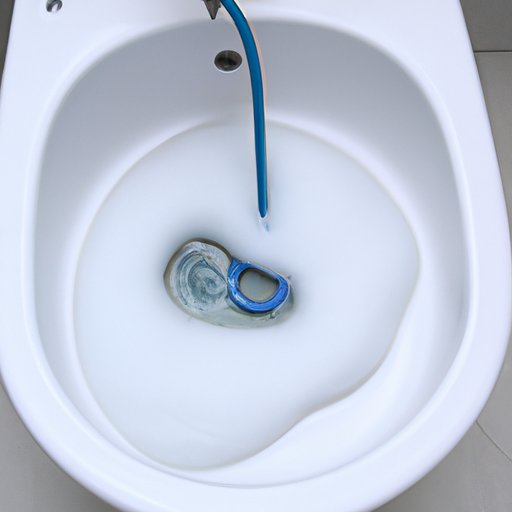I. Introduction
Dealing with a clogged toilet is never a pleasant experience, but it can be especially frustrating if you don’t have a plunger on hand. Fortunately, there are several effective methods you can use to unclog a toilet without a plunger. In this article, we will outline six of the most effective solutions that you can try in order to solve this common household problem.
II. Use a Homemade Drain Snake
If you have a wire clothes hanger, you can easily create a drain snake to help unclog your toilet. Straighten out the hanger, leaving a small hook at one end. Insert the hooked end into the toilet drain and twist it around, using the hook to break up and pull out any obstructions. Be sure to wear rubber gloves and dispose of any waste in a garbage bag.
It’s important to exercise caution when using a homemade drain snake, as you don’t want to damage your toilet or cause injury to yourself. Be gentle and patient, and don’t force the hanger down the toilet if it’s not moving easily.
III. Hot Water and Detergent
Hot water and detergent is another effective method for unclogging a toilet. Add a few tablespoons of liquid dish soap to a vessel of hot (not boiling) water and slowly pour the mixture into the toilet bowl. Let the mixture sit for a few minutes before flushing the toilet. The soap will help to break down any obstruction, while the hot water will soften the waste and make it easier to flush away.
It’s important to note that the water should be hot, but not boiling. Boiling water can crack your toilet bowl and cause injury if you accidentally spill it. Additionally, only use detergent that’s safe for septic systems to avoid causing damage to your plumbing.
IV. Baking Soda and Vinegar
Baking soda and vinegar is a natural and effective solution for unclogging toilets. Start by pouring a cup of baking soda directly into your toilet bowl, making sure to distribute it evenly around the rim. Next, pour a cup of vinegar into the bowl, making sure to pour it slowly so that it doesn’t overflow. Let the mixture sit for about 10-15 minutes before pouring hot water into the bowl and flushing it.
It’s important to use equal parts baking soda and vinegar, so be sure to measure carefully. Additionally, make sure to use white vinegar, as other types of vinegar may not be as effective.
V. Boiling Water
If you have a sturdy and durable toilet bowl, you can use boiling water to unclog your toilet. Start by boiling a pot of water, making sure to use a large pot so that you have enough water to work with. Once the water is boiling, carefully pour it into the toilet bowl, making sure to pour it in a slow and steady stream.
It’s important to note that not all toilet bowls can handle boiling water, and pouring boiling water into a toilet bowl that’s not built to handle it can crack or otherwise damage the bowl. Additionally, exercise caution when handling boiling water to avoid injury.
VI. Dish Soap
Dish soap can help to lubricate the pipes in your toilet, making it easier for waste to slide through. Pour a few tablespoons of dish soap into the toilet bowl and let it sit for a few minutes. Next, pour hot (but not boiling) water into the bowl and flush the toilet.
It’s important to note that you should only use dish soap that’s safe for use in septic systems. Additionally, don’t use too much soap, as this can create excess suds that may actually make the clog worse.
VII. Wet/Dry Vacuum
If you have access to a wet/dry vacuum, you can use it to suck out the obstruction in your toilet. Use the vacuum’s hose and extension to suck out any waste, taking care not to touch the inside of the toilet bowl with the vacuum’s nozzle.
It’s important to use a wet/dry vacuum, as other types of vacuums may not be suitable for this task. Additionally, make sure to clean and sanitize the vacuum’s hose and nozzle after using it in the toilet.
VIII. Conclusion
Clogged toilets can be a frustrating problem, but they don’t have to be a major headache. By using one of these six methods, you can quickly and easily unclog your toilet without the need for a plunger. Give each method a try and find out which one works best for your particular situation.
Remember to exercise caution and take safety precautions when using any of these methods, and call a professional if you’re unable to unclog your toilet on your own.
